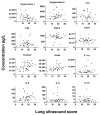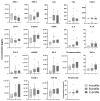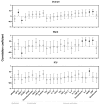Correlation between Serum Biomarkers and Lung Ultrasound in COVID-19: An Observational Study
- PMID: 38396460
- PMCID: PMC10888244
- DOI: 10.3390/diagnostics14040421
Correlation between Serum Biomarkers and Lung Ultrasound in COVID-19: An Observational Study
Abstract
Serum biomarkers and lung ultrasound are important measures for prognostication and treatment allocation in patients with COVID-19. Currently, there is a paucity of studies investigating relationships between serum biomarkers and ultrasonographic biomarkers derived from lung ultrasound. This study aims to assess correlations between serum biomarkers and lung ultrasound findings. This study is a secondary analysis of four prospective observational studies in adult patients with COVID-19. Serum biomarkers included markers of epithelial injury, endothelial dysfunction and immune activation. The primary outcome was the correlation between biomarker concentrations and lung ultrasound score assessed with Pearson's (r) or Spearman's (rs) correlations. Forty-four patients (67 [41-88] years old, 25% female, 52% ICU patients) were included. GAS6 (rs = 0.39), CRP (rs = 0.42) and SP-D (rs = 0.36) were correlated with lung ultrasound scores. ANG-1 (rs = -0.39) was inversely correlated with lung ultrasound scores. No correlations were found between lung ultrasound score and several other serum biomarkers. In patients with COVID-19, several serum biomarkers of epithelial injury, endothelial dysfunction and immune activation correlated with lung ultrasound findings. The lack of correlations with certain biomarkers could offer opportunities for precise prognostication and targeted therapeutic interventions by integrating these unlinked biomarkers.
Keywords: COVID-19; SARS-CoV-2; endothelial dysfunction; epithelial injury; immune activation; lung; respiratory failure; ultrasonography.
Conflict of interest statement
The authors declare no conflicts of interest.
Figures







References
-
- Matthay M.A., Arabi Y.M., Siegel E.R., Ware L.B., Bos L.D.J., Sinha P., Beitler J.R., Wick K.D., Curley M.A.Q., Constantin J.M., et al. Phenotypes and personalized medicine in the acute respiratory distress syndrome. Intensive Care Med. 2020;46:2136–2152. doi: 10.1007/s00134-020-06296-9. - DOI - PMC - PubMed
LinkOut - more resources
Full Text Sources
Research Materials
Miscellaneous

